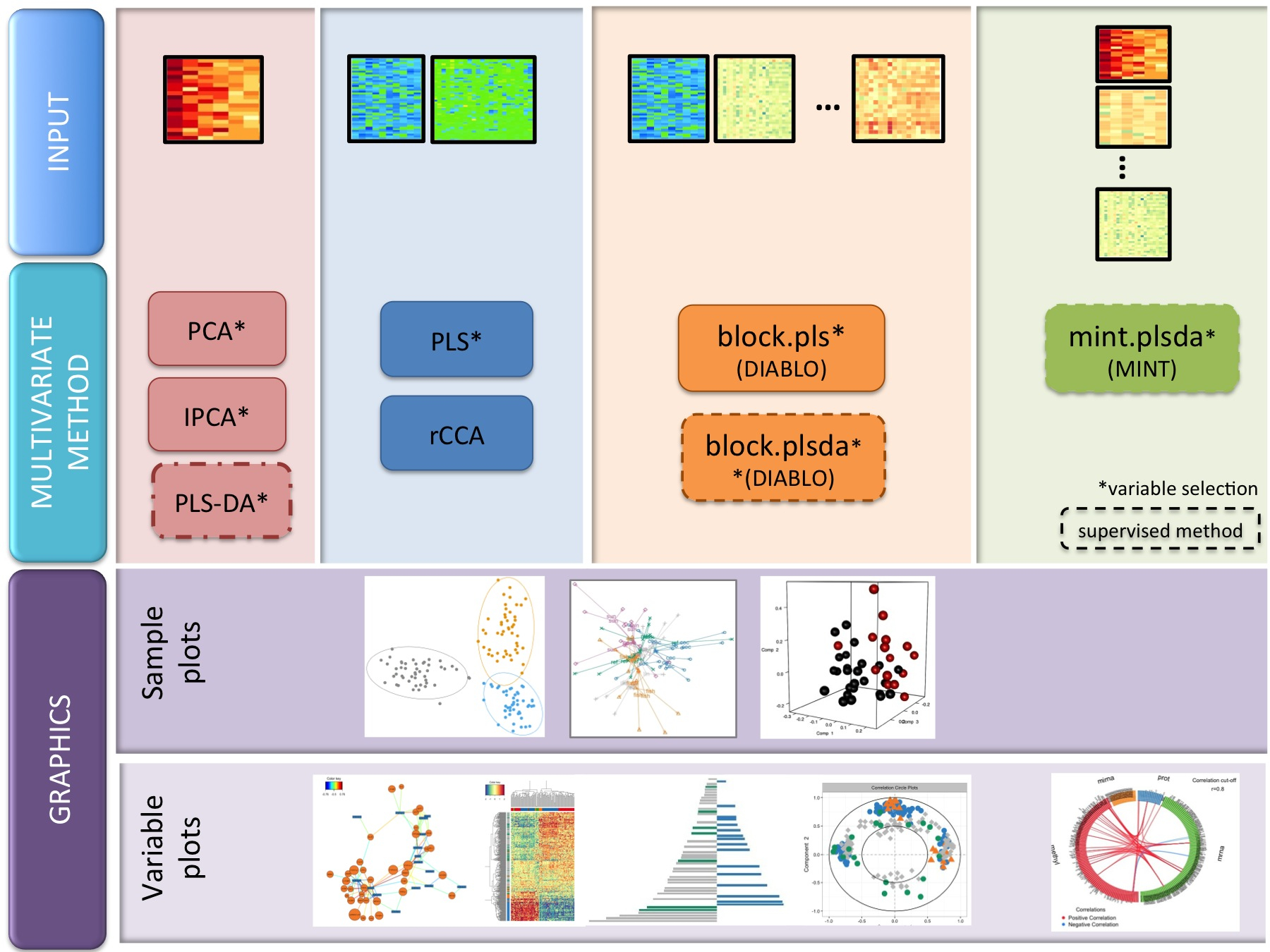This repository contains the R package which is hosted on
Bioconductor
and our stable and development GitHub versions.
(macOS users only: Ensure you have installed XQuartz first.)
The best way to install mixOmics is using Bioconductor. You can see
the landing page for the release version of mixOmics on Bioconductor
here.
Make sure you have the latest R version and the latest BiocManager
package installed following these
instructions.
## install BiocManager if not installed
if (!requireNamespace("BiocManager", quietly = TRUE))
install.packages("BiocManager")
## install mixOmics
BiocManager::install('mixOmics')
## load mixOmics
library(mixOmics) Bioconductor versions are updated twice a year, between these updates
you can downlod the latest stable version of mixOmics from Github
using:
BiocManager::install('mixOmicsTeam/mixOmics')You can also install the development version for new features yet to be widely tested:
BiocManager::install("mixOmicsTeam/mixOmics@development")You can install our latest stable Github version of mixOmics via our
Docker container. You can do this by downloading and using the Docker
desktop application or via the command line as described below.
Click to expand
Note: this requires root privileges
- Install Docker following instructions at https://docs.docker.com/docker-for-mac/install/
if your OS is not compatible with the latest version download an older version of Docker from the following link:
- MacOS: https://docs.docker.com/docker-for-mac/release-notes/
- Windows: https://docs.docker.com/docker-for-windows/release-notes/
Then open your system’s command line interface (e.g. Terminal for MacOS and Command Promot for Windows) for the following steps.
MacOS users only: you will need to launch Docker Desktop to activate your root privileges before running any docker commands from the command line.
- Pull mixOmics container
docker pull mixomicsteam/mixomics- Ensure it is installed
The following command lists the running images:
docker imagesThis lists the installed images. The output should be something similar to the following:
$ docker images
> REPOSITORY TAG IMAGE ID CREATED SIZE
> mixomicsteam/mixomics latest e755393ac247 2 weeks ago 4.38GB
- Activate the container
Running the following command activates the container. You must change
your_password to a custom password of your own. You can also customise
ports (8787:8787) if desired/necessary. see
https://docs.docker.com/config/containers/container-networking/ for
details.
docker run -e PASSWORD=your_password --rm -p 8787:8787 mixomicsteam/mixomics- Run
In your web browser, go to http://localhost:8787/ (change port if
necessary) and login with the following credentials:
username: rstudio
password: (your_password set in step 4)
- Inspect/stop
The following command lists the running containers:
sudo docker psThe output should be something similar to the following:
$ sudo docker ps
> CONTAINER ID IMAGE COMMAND CREATED STATUS PORTS NAMES
> f14b0bc28326 mixomicsteam/mixomics "/init" 7 minutes ago Up 7 minutes 0.0.0.0:8787->8787/tcp compassionate_mestorfThe listed image ID can then be used to stop the container (here
f14b0bc28326)
docker stop f14b0bc28326We welcome community contributions concordant with our code of
conduct.
We strongly recommend adhering to Bioconductor’s coding
guide for
software consistency if you wish to contribute to mixOmics R codes.
To report a bug (or offer a solution for a bug!) visit: https://github.com/mixOmicsTeam/mixOmics/issues. We fully welcome and appreciate well-formatted and detailed pull requests. Preferably with tests on our datasets.
Set up development environment
- Install the latest version of R
- Install RStudio
- Clone this repo, checkout master branch, pull origin and then run:
install.packages("renv", Ncpus=4)
install.packages("devtools", Ncpus=4)
# restore the renv environment
renv::restore()
# or to initialise renv
# renv::init(bioconductor = TRUE)
# update the renv environment if needed
# renv::snapshot()
# test installation
devtools::install()
devtools::test()
# complete package check (takes a while)
devtools::check()We wish to make our discussions transparent so please direct your analysis questions to our discussion forum https://mixomics-users.discourse.group. This forum is aimed to host discussions on choices of multivariate analyses, as well as comments and suggestions to improve the package. We hope to create an active community of users, data analysts, developers and R programmers alike! Thank you!
mixOmics is collaborative project between Australia (Melbourne),
France (Toulouse), and Canada (Vancouver). The core team includes
Kim-Anh Lê Cao - https://lecao-lab.science.unimelb.edu.au (University
of Melbourne), Florian Rohart - http://florian.rohart.free.fr
(Toulouse) and Sébastien Déjean -
https://perso.math.univ-toulouse.fr/dejean/. We also have key
contributors, past (Benoît Gautier, François Bartolo) and present (Al
Abadi, University of Melbourne) and several collaborators including
Amrit Singh (University of British Columbia), Olivier Chapleur (IRSTEA,
Paris), Antoine Bodein (Universite de Laval) - it could be you too, if
you wish to be involved!.
The project started at the Institut de Mathématiques de Toulouse in
France, and has been fully implemented in Australia, at the University
of Queensland, Brisbane (2009 – 2016) and at the University of
Melbourne, Australia (from 2017). We focus on the development of
computational and statistical methods for biological data integration
and their implementation in mixOmics.
mixOmics offers a wide range of novel multivariate methods for the
exploration and integration of biological datasets with a particular
focus on variable selection. Single ’omics analysis does not provide
enough information to give a deep understanding of a biological system,
but we can obtain a more holistic view of a system by combining multiple
’omics analyses. Our mixOmics R package proposes a whole range of
multivariate methods that we developed and validated on many biological
studies to gain more insight into ’omics biological studies.
www.mixOmics.org (tutorials and resources)
Our latest bookdown vignette: https://mixomicsteam.github.io/mixOmics-Vignette/
We have developed 17 novel multivariate methods (the package includes 19 methods in total). The names are full of acronyms, but are represented in this diagram. PLS stands for Projection to Latent Structures (also called Partial Least Squares, but not our preferred nomenclature), CCA for Canonical Correlation Analysis.
That’s it! Ready! Set! Go!
Thank you for using mixOmics!
- enhancement request
#216
implemented parallel processing using
BPPARAMacross alltune()functions - feature request
#335 added
seedargument toperf()functions for better reproducibility - feature request
#334 added
seedargument totune()functions for better reproducibility - bug fix implemented for
#303 multiple
solutions found in
perf()returns error - bug fix implemented for
#307
plotIndiv()ellipses colours not matching points, now sample group order is respected and colours can be customised for points and ellipses - updated documentation to fix issue #297 broken link in bookdown vignette
- updated documentation to fix issue #296 typo in vignette
The performance assessment and parameter tuning workflow has been streamlined as described in issue #343
-
New function:
perf.assess()This function essentially runsperf()on final model but only returns performance metrics for the number of components used in the final model. Designed to be used in the final step of the workflow for quantifying final model performance. Outputs a list of values but no plotting functionality avaliable. See PR 344 for more details. -
Additional functionality for
tune()functions and newtune()functions createdtune()can now be used in its original capacity (to tune number of variables and components simultaneously) or just to tune number of components by internally callingperf(). Designed to be used for tuning both components and variables to keep across (s)PCA, (s)PLS, (s)PLSDA, block (s)PLSDA and mint (s)PLSDA models See PR #348 for more details.
** Version 6.30.0 **
Bioconductor release version 6.30.0 released end of October 2024 Minor bug fixes and updated deprecated code and unit tests, no major code changes and no changes to user experience of mixOmics.
- bug fix implemented for
#293
splsda()example code error
- bug fix implemented for Issue
#196.
perf()can now handle features with a(s)plswhich have near zero variance. - bug fix implemented for Issue
#192.
predict()can now handle when the testing and training data have their columns in different orders. - bug fix implemented for Issue
#178. If the
indYparameter is used inblock.spls(),circosPlot()can now properly identify the$Y$ dataframe. - bug fix implemented for Issue
#172.
perf()now returns values for thechoice.ncompcomponent whennrepeat$< 3$ whereas before it would just returnNAs. - bug fix implemented for Issue
#171.
cim()now can takepcaobjects as input. - bug fix implemented for Issue
#161.
tune.spca()can now handleNAvalues appropriately. - bug fix implemented for Issue
#150. Provided
users with a specific error message for when
plotArrow()is run on a(mint).(s)plsdaobject. - bug fix implemented for Issue
#122. Provided
users with a specific error message for when a
splsdaobject that has only one sample associated with a given class is passed toperf(). - bug fix implemented for Issue
#120.
plotLoadings()now returns the loading values for features from all dataframes rather than just the last one when operating on a(mint).(block).(s)plsdaobject. - bug fix implemented for Issue
#43. Homogenised
the way in which
tune.mint.splsda()andperf.mint.splsda()calculate balanced error rate (BER) as there was disparity between them. Also made the global BER a weighted average of BERs across each study. - enhancement implemented for Issue
#30/#34. The
parameter
verbose.callwas added to most of the methods. This parameter allows users to access the specific values input into the call of a function from its output. - bug fix implemented for Issue
#24.
background.predict()can now operate onmint.splsdaobjects and can be used as part ofplotIndiv().
- new function
plotMarkersto visualise the selected features in block analyses (see #134) tune.splsnow able to tune the selected variables on bothXandY. See?tune.spls- new function
impute.nipalsto impute missing values using the nipals algorithm - new function
tune.spcato tune the number of selected variables for pca components circosPlotnow has methods forblock.splsobjects. It can now handle similar feature names across blocks. It is also much more customisable. See advanced arguments in?circosPlot- new
biplotfunction forpcaandplsobjects. See?mixOmics::biplot plotDiablonow takescol.per.group(see #119)
- weighted consensus plots for DIABLO objects now consider per-component weights
plotIndivnow supports (weighted) consensus plots for block analyses. See the example in this issueplotIndiv(..., ind.names=FALSE)warning issue now fixed
perf.block.splsdanow supports calculation of combined AUCblock.splsdabug which could drop some classes withnear.zero.variance=TRUEnow fixed

-lightgrey.svg)

